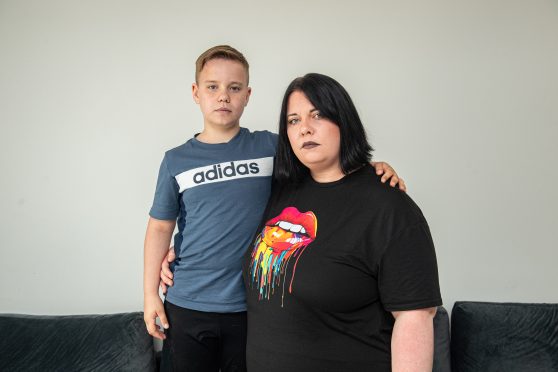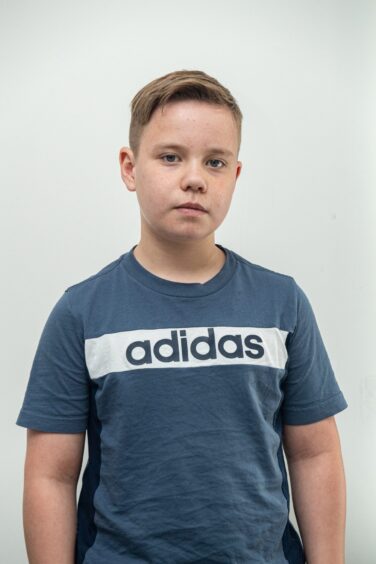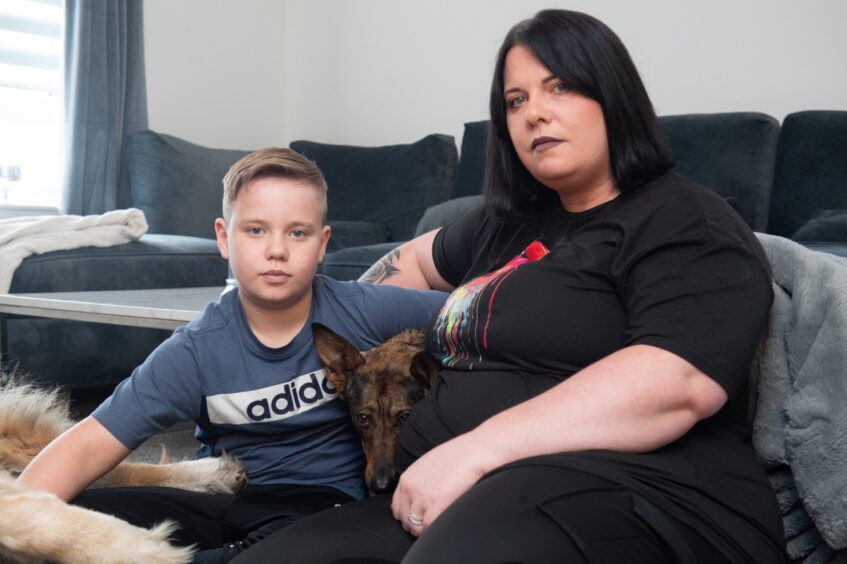
A young boy suffered 18 months of violent bullying while his school repeatedly refused to exclude his tormentors.
Now mum Zoe Sharpe is calling on the Scottish Government to toughen its guidance to encourage headteachers to exclude the worst offenders.
Scottish Government guidelines say pupils should only be excluded as a last resort.
Sharpe said that, during his time at New Elgin Primary, her son Tommy, who has attention deficit hyperactivity disorder (ADHD), was bullied by three different groups of boys over 18 months and each time the school and Moray Council refused to expel the boys involved.
Bullying incidents
One serious assault that left Tommy with concussion was filmed on the school’s CCTV.
The ringleader was suspended for one day then sent out of school on a series of activities – including a trip to McDonald’s.
In another incident, Tommy was beaten up in the school toilets. The assault was filmed by the attackers and shared on social media.
Sharpe said the bullying began when Tommy started school after the family moved from Cyprus to Elgin. Two boys would chase him and beat him up every day. The bullying stopped when the two boys fell out, but then another boy and his friends began to pick on Tommy.
The school reassured the Sharpes it was doing everything it could to stop the bullying, but the attacks became worse.
In one – caught on the school’s CCTV – Tommy was punched 23 times by the bully and his friends.
Sharpe said: “The headteacher said it had been one of the worst attacks she had seen in her whole career. She said you need to get the police involved.
“The police came and we took Tommy to the hospital. He had a severe concussion. He remained off school for a week.
“We had a meeting with the school and they informed us they were not excluding the boy because the Scottish Parliament had set this in their exclusion policy and Moray Council adhered to this policy – and they have a no-exclusion policy as well.”
‘The school said they’d investigate. Nothing came of it’
Sharpe was unable to remove Tommy from the school – the only primary in the area catering for additional support needs.
With six weeks left in term, the bully remained in school and was taken to McDonalds to try and keep him away from Tommy.
The school assured Sharpe the bullying would stop because the bully and his friends had moved to high school. But, Tommy was bullied again. Sharpe said: “They locked him in a bathroom. There were four of them. One stood at the door keeping him in, one was filming and the others were kicking him. They beat him up, kicking him, stamping on his legs and they were laughing. When they were done filming they let him out. The video was uploaded to Snapchat.
“When we sent an email to the school about it, they said we’ll investigate. Nothing came of it.”
The family sent two complaints to the council – in February 2024 and May 2024. Sharpe says the bullying continued and Tommy’s mental health was affected.
Another incident occurred when Tommy was attacked but chose to defend himself. One of the bullies had a metal chain and, during the altercation, the chain cut into the bully’s hand.
Days later, Tommy’s parents received a letter from the school threatening to suspend him.
The Sharpes have deregistered Tommy and have decided to relocate to England.
Moray Council said: “In this instance, the staff team is working hard with all involved to resolve any issues through a variety of support options. There is an expectation from the Scottish Government that we do not exclude children.”
When asked why one of the bullies was taken to McDonald’s, the council said: “We can’t comment on a specific child’s plan but a variety of support options are put in place, which aim to improve the situation for all concerned.”
A Scottish Government spokesperson said: “The Scottish Government does not have a no-exclusion policy. It is the responsibility of local authorities to agree exclusion policy for schools. However, our guidance is clear that, while it should be a last resort, schools have the option to consider exclusion.
“Violence and abusive behaviour towards pupils or staff is unacceptable. Bullying must be addressed quickly whenever it arises. We expect all schools to develop and implement an anti-bullying policy.”
Expert view: ‘Blighted by seriously harmful content they can’t avoid’
More and more children are being exposed to fights and violent videos on social media, research suggests.
A study commissioned by Ofcom earlier this year found that youngsters first see violence online while still at primary school and described it as an inevitable part of being online.
Sharing videos of local school and street fights has also become normalised.
Ofcom chief executive Dame Melanie Dawes said: “We want children to enjoy life online. But, for too long, their experiences have been blighted by seriously harmful content which they can’t avoid or control.
“Many parents share feelings of frustration and worry about how to keep their children safe. That must change.” YouthLink Scotland found similar results in their The Lassies Are No Feart research.
Emily Beever, senior development officer of YouthLink Scotland, said: “Young people told us they are exposed daily to extreme violent content on social media and that it has a long-lasting impact on them.”
She added: “To make matters worse, young people had little confidence in the social media companies’ reporting mechanisms.”
Teachers’ view: ‘Culture of silence needs to change’
Teachers must be allowed to speak out without fear of disciplinary action or losing their job, says the UK Government’s advisor on school behaviour.
The Sunday Post has reported on the violence in schools and the immense pressure school workers are under, with many wanting to speak out about how difficult it is, but being unable to reveal their identity or where they work.
Tom Bennett, known as “the behaviour tsar”, is chair of a taskforce aimed at tackling misbehaviour and said he had spoken to many teachers who want to talk about problems but are afraid to speak out.
He said: “I’ve spoken to scores of teachers who want to speak out about the problems they face in schools, but know that if they did, they would be reprimanded or sanctioned by their line management. Because they would also be disciplined or chastised by their bosses. And so it goes, all the way to the top of education.
“There is an omertà in Scottish education: a code of silence – Don’t go public with how bad things are for you; don’t complain; don’t rock the boat. So teachers are right to be worried. They would be in trouble if they broke this code.
“The entire culture of silence needs to change.”
One teacher, who works in a school in Dundee, said she would love to open up about everything that goes on at her school, but cannot due to her fear of losing her job.
“Even with all the issues that we as teachers now face, I love my job and I wouldn’t want to lose it because I spoke out about an incident, even though I should be able to, I’m not in the position where I can.
“I feel like a lot of other teachers feel the same.”
Mike Corbett, of the NASUWT National Official Scotland, said that teachers should be supported when talking about what is going on in schools.
He said: “Openness and transparency are the only ways to fully get a grasp of the scale of violence and abuse from pupils and to formulate sustainable, effective solutions to tackle it. Teachers should feel supported to report and speak up about violence, that the majority currently do not indicates the depth of the challenge we face in addressing abuse in schools.”

Enjoy the convenience of having The Sunday Post delivered as a digital ePaper straight to your smartphone, tablet or computer.
Subscribe for only £5.49 a month and enjoy all the benefits of the printed paper as a digital replica.
Subscribe
